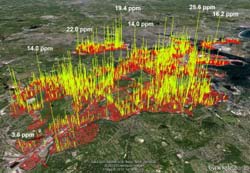Thousands of Natural Gas Leaks Discovered in Boston

Nathan Phillips, Boston University<br> <br>Image showing relative volume of methane leaks at various locations around Boston.<br>
Their findings appear this week in the online edition of the peer-reviewed journal Environmental Pollution [Phillips, N.G., et al., Mapping urban pipeline leaks: Methane leaks across Boston, Environmental Pollution (2012), http://dx.doi.org/10.1016/j.
envpol.2012.11.003].
The new study comes in the wake of devastating fires fueled by natural gas during Hurricane Sandy. Potential damage to gas pipeline pressure regulators, caused by flooding in Hurricane Sandy, has raised ongoing safety concerns in New York and New Jersey.
The researchers report finding 3,356 separate natural gas leaks under the streets of Boston. “While our study was not intended to assess explosion risks, we came across six locations in Boston where gas concentrations exceeded the threshold above which explosions can occur,” said Nathan Phillips, associate professor in BU’s Department of Earth and Environment and co-author of the study.
Nationally, natural gas pipeline failures cause an average of 17 fatalities, 68 injuries, and $133M in property damage annually, according to the U.S. Pipeline and Hazardous Materials Safety Administration. In addition to the explosion hazard, natural gas also poses a major environmental threat: Methane, the primary ingredient of natural gas, is a powerful greenhouse gas that degrades air quality. Leaks in the United States contribute to $3 billion of lost and unaccounted for natural gas each year.
“Repairing these leaks will improve air quality, increase consumer health and safety, and save money,” said co-author Robert B. Jackson, Nicholas Professor of Global Environmental Change at Duke. “We just have to put the right financial incentives into place.”
Phillips and Jackson’s teams collaborated with industry partners Robert Ackley of Gas Safety, Inc., and Eric Crosson of Picarro, Inc., on the study. They mapped the gas leaks under Boston using a new, high-precision methane analyzer installed in a GPS-equipped car. Driving all 785 road miles within city limits, the researchers discovered 3,356 leaks.
The leaks were distributed evenly across neighborhoods and were associated with old cast-iron underground pipes, rather than neighborhood socioeconomic indicators. Levels of methane in the surface air on Boston’s streets exceeded fifteen times the normal atmospheric background value.
Like Boston, other cities with aging pipeline infrastructure may be prone to leaks. The researchers recommend coordinated gas-leaks mapping campaigns in cities where the infrastructure is deemed to be at risk. The researchers will continue to quantify the health, safety, environmental, and economic impacts of the leaks, which will be made available to policymakers and utilities as they work to replace and repair leaking natural gas pipeline infrastructure.
Lucy Hutyra, Assistant Professor and Max Brondfield, technician, worked with Phillips on this study at Boston University. At Duke, PhD student Adrian Down, postdoctoral researcher Kaiguang Zhao, and research scientist Jon Karr assisted Jackson with his research.
The study was supported by the Barr Foundation, Conservation Law Foundation, National Science Foundation, Picarro, Inc., Boston University and Duke University.
About Boston University
Founded in 1839, Boston University is an internationally recognized private research university with more than 30,000 students participating in undergraduate, graduate, and professional programs. As Boston University’s largest academic division, the College and Graduate School of Arts & Sciences is the heart of the BU experience with a global reach that enhances the University’s reputation for teaching and research.
Link to article:
http://www.sciencedirect.com/science/article/pii/S0269749112004800
Author contacts:
Nathan Phillips, associate professor
Department of Earth & Environment
Boston University
(617) 353-2841
nathan@bu.edu
Robert B. Jackson, professor
Nicholas School of the Environment
Duke University
(919) 660-7408
jackson duke.edu
Media Contact
More Information:
http://www.bu.eduAll latest news from the category: Earth Sciences
Earth Sciences (also referred to as Geosciences), which deals with basic issues surrounding our planet, plays a vital role in the area of energy and raw materials supply.
Earth Sciences comprises subjects such as geology, geography, geological informatics, paleontology, mineralogy, petrography, crystallography, geophysics, geodesy, glaciology, cartography, photogrammetry, meteorology and seismology, early-warning systems, earthquake research and polar research.
Newest articles

A universal framework for spatial biology
SpatialData is a freely accessible tool to unify and integrate data from different omics technologies accounting for spatial information, which can provide holistic insights into health and disease. Biological processes…

How complex biological processes arise
A $20 million grant from the U.S. National Science Foundation (NSF) will support the establishment and operation of the National Synthesis Center for Emergence in the Molecular and Cellular Sciences (NCEMS) at…

Airborne single-photon lidar system achieves high-resolution 3D imaging
Compact, low-power system opens doors for photon-efficient drone and satellite-based environmental monitoring and mapping. Researchers have developed a compact and lightweight single-photon airborne lidar system that can acquire high-resolution 3D…





















